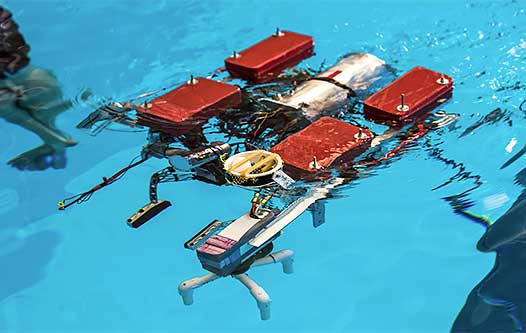Taking a Deep Dive into Robotics

Robotics may be fun and games for some. To the Rose-Hulman Robotics Team, this is serious business. They’re developing cutting-edge skills on land, sea and air.
If anyone thought robotics meant kids’ toys or assembly-line automation, the Fukushima Daiichi nuclear disaster (2011) exploded that image. Robots ventured where humans could not, struggling to stabilize a precarious situation.
The next generation of robotics engineers is training at Rose-Hulman, devising ways to work in challenging environments—under water, in the air, or in combat. This year, the Robotics Team addressed a daunting mission: Engineer a tethered underwater robot to remove and replace an electrically operated pump mechanism.
The skills developed, says Ryder Winck, assistant professor of mechanical engineering, apply to other environments such as space or nuclear disaster sites. Winck and Assistant Prof. Simon Jones serve as advisors for the Robotics Team. Like other Rose-Hulman teams, these efforts benefit from a cross-disciplinary squad that includes Electrical Engineering and Computer Science majors.
In the realm of combat robotics, the team is developing a new entry in the one-pound class. That weight restriction, says Winck, requires carefully balancing needs for power, weaponry and armor. Plastic parts—some made with 3D printing—are part of the strategy. Next spring will also see the debut of an autonomous land vehicle, an aerial robot with quad rotors, and the next iteration of underwater robot technology.

